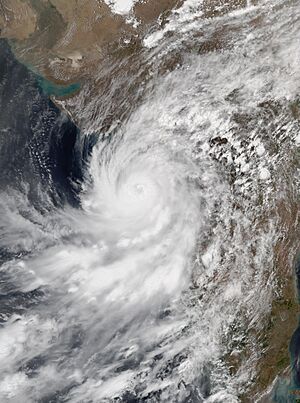Cyclone Nisarga facts for kids

Severe Cyclonic Storm Nisarga was a powerful tropical cyclone that hit the western coast of India in June 2020. It formed over the Arabian Sea and quickly grew stronger as it moved towards the state of Maharashtra.
Nisarga was a very important storm because it was the first severe cyclone to directly affect the city of Mumbai since 1891. This made it a rare and historic weather event for the region.
Contents
What was Cyclone Nisarga?
A tropical cyclone is a type of storm system that forms over warm ocean waters. It has a low-pressure center and many thunderstorms that produce strong winds and heavy rain. These storms are also known as hurricanes or typhoons in other parts of the world.
Nisarga started as a low-pressure area in the Arabian Sea. The India Meteorological Department (IMD), which is India's main weather agency, watched it closely. On June 2, 2020, the IMD announced that Nisarga had become a "severe cyclonic storm." This meant it had very strong winds and was expected to cause significant impact.
Where did Nisarga make landfall?
"Landfall" is when the center of a cyclone crosses over from the ocean to the land. Cyclone Nisarga made its landfall on June 3, 2020. It hit the coastal town of Alibag in Maharashtra. Alibag is located south of Mumbai.
Even though the storm's center hit Alibag, its strong winds and heavy rains affected a much wider area, including Mumbai. People in these areas had to prepare for the storm by moving to safer places and securing their homes.
Why was Nisarga special?
Nisarga was special for a few reasons:
- It was the first severe cyclonic storm to hit Mumbai in 129 years, since 1891.
- It was also the first "super cyclonic storm" to form in the Bay of Bengal in the 21st century. This shows how powerful it became.
The storm caused some damage, like uprooted trees and damaged homes, but thankfully, the preparations made by the government and people helped to reduce the impact and keep everyone safe.
See also
 In Spanish: Ciclón Nisarga para niños
In Spanish: Ciclón Nisarga para niños

